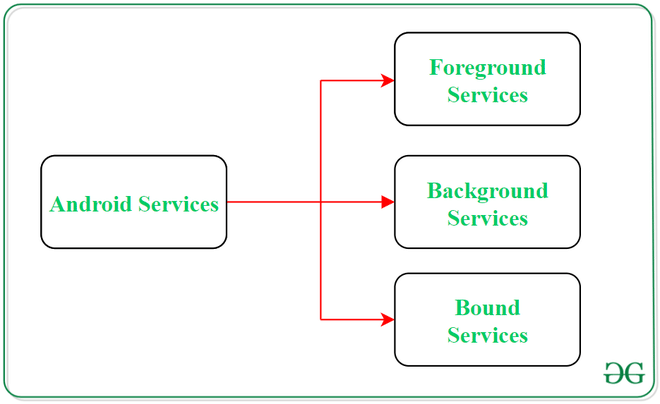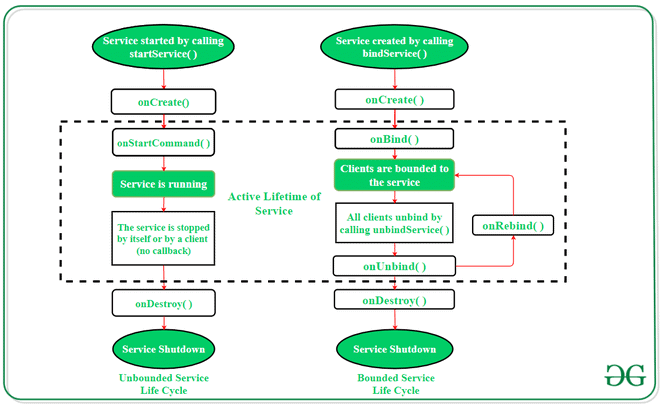Services in Android with Example - Software Development PDF Download
- Overview of Services in Android:
- Services in Android are specialized components that enable applications to run in the background for executing long-running tasks.
- They ensure that an application stays active in the background, allowing users to multitask with multiple applications simultaneously.
- Unlike activities, services do not require a user interface and are designed for long-running processes without user intervention.
- Services can continue running in the background even when the application is not visible or when the user switches to another app.
- Key Differences between Services and Threads:
- Threads, provided by the operating system, enable background operations, while services are Android components for long-running operations without a UI.
- Services are intended for processes that users may not need to interact with directly, unlike threads that are more user-focused.
- Inter-process Communication (IPC) in Android:
- Applications can bind themselves to services to facilitate inter-process communication (IPC).
- IPC allows different components of an application to communicate with each other, even if they are running in separate processes.
- For example, an activity can bind to a service to fetch data from a remote server in the background.
Types of Android Services

- Foreground Services:
Foreground Services are those that keep the user informed about ongoing operations. For instance, when downloading a file, users receive notifications about the progress and can control the process by pausing or resuming it.
- Background Services:
Background Services operate without requiring user interaction. They handle tasks such as scheduled data synchronization or data storage without notifying the user or allowing user access.
- Bound Services:
Bound Services enable application components like activities to connect to them. These services execute tasks as long as any application component remains connected. Multiple components can bind to a service simultaneously using the bindService() method.
- Foreground Services:
The Life Cycle of Android Services
In the realm of Android, services follow two lifecycle paths: Started and Bound.
- Started Service (Unbounded Service):
When a service takes the 'Started Service' path, it begins upon a call to the startService() method by an application component. Once activated, the service can persist in the background even if the initiating component is terminated. There are two options available to halt the service's execution.
Android Services Overview
By following this path, a service will initiate when an application component calls the startService() method. Once initiated, the service can run continuously in the background even if the component is destroyed which was responsible for the start of the service.
- Two options are available to stop the execution of a service:
- By calling stopService() method,
- The service can stop itself by using stopSelf() method.
Bounded Service
It can be treated as a server in a client-server interface. Android application components can send requests to the service and fetch results. A service is termed as bounded when an application component binds itself with a service by calling bindService() method.
To stop the execution of this service, all the components must unbind themselves from the service by using unbindService() method.

To carry out a downloading task in the background, the startService() method will be called. To get information regarding the download progress and to pause or resume the process while the application is still in the background, the service must be bounded with a component which can perform these tasks.
- Fundamentals of Android Services
- User-defined Service Creation
- A user-defined service in Android is generated through a standard class that extends the Service class.
- For service operations on applications, specific callback methods need to be overridden.
- Important Methods of Android Services
- onStartCommand()
- The onStartCommand() method is triggered by the Android service when a component like an activity requests to initiate a service using startService().
- After starting the service, it can be explicitly halted through methods like stopService() or stopSelf().
- onBind()
- The onBind() method is essential in Android services and is called whenever an application component invokes the bindService() method to link itself with a service.
- It facilitates effective communication with the service by offering a User Interface through the return of an IBinder object.
- If service binding is unnecessary, the method should return null.
- onStartCommand()
- User-defined Service Creation
Service Lifecycle
- Binding with a Service
When a component binds itself with a service, it can effectively communicate with the service by returning an IBinder object.
If the service binding is not necessary, the method should return null.
- onUnbind()
This method is called by the Android system when all clients are disconnected from a specific service interface.
- onRebind()
When all clients have disconnected from a service's particular interface and there is a need to connect with new clients, this method is invoked.
- onCreate()
Whenever a service is created through onStartCommand() or onBind(), this method is called by the Android system. It is essential for performing one-time setup tasks.
- onDestroy()
Before a service is destroyed, the system triggers this method for final cleanup. Services should implement this method to tidy up resources like registered listeners, threads, receivers, etc.
Implementing Resource Cleanup Method
- Implement this method to clean up resources like registered listeners, threads, receivers, etc.
Example of Android Services
Playing music in the background is a common example of services in Android. When a user starts the service, music continues playing in the background even if the user switches to another application. The user must explicitly stop the service to pause the music. Below is a step-by-step implementation of an Android service using callback methods:
Note: Following steps are performed on Android Studio version 4.0
Step 1: Create a new project
- Click on File, then New => New Project.
- Choose Empty Views Activity
- Select language as Java/Kotlin
- Select the minimum SDK as per your need.
Step 2: Modify strings.xml file
All the strings used in the activity are listed in this file.
<resources> <string name="app_name">Services_In_Android</string> <string name="heading">Services In Android</string> <string name="startButtonText">Start the Service</string> <string name="stopButtonText">Stop the Service</string> </resources> Step 3: Working with the activity_main.xml file
Describe the content and purpose of the activity_main.xml file here.
Adding Buttons to Activity Layout
- Add two buttons to the activity_main.xml file to control the service.
- Buttons should be designed to start and stop the service.
- Code snippet for designing the activity layout is provided.
Designing Activity Layout Code
- Open the activity_main.xml file.
- Add two buttons: Start Button and Stop Button.
- Customize the buttons with appropriate attributes like layout width, height, margins, background color, text appearance, and more.
- Include an ImageView in the layout as well.
Creating the Custom Service Class
- Develop a custom service class to manage the service functionality.
- The service class should include methods to start and stop the service.
- Implement necessary logic to handle service operations effectively.
Example for Custom Service Class
- In the service class, define a method named startService() to initiate the service.
- Implement a stopService() method to halt the service when required.
- Utilize the Android Service framework to create a robust service class.
Creating a Custom Service for Media Playback in Android
A custom service class will be created in the same directory where the MainActivity class resides. This class will extend the Service class and utilize callback methods to initiate and terminate services. To facilitate music playback, the MediaPlayer object will be employed.
Code Implementation in Java
- A custom service class, named NewService, will be developed to manage media playback.
- The class will extend the Service class.
- The MediaPlayer object will be utilized for playing audio.
- Below is the Java code snippet for implementing this functionality:
import android.app.Service; import android.content.Intent; import android.media.MediaPlayer; import android.os.IBinder; import android.provider.Settings; import androidx.annotation.Nullable; public class NewService extends Service { // declaring object of MediaPlayer private MediaPlayer player; @Override public int onStartCommand(Intent intent, int flags, int startId) { player = MediaPlayer.create(this, Settings.System.DEFAULT_RINGTONE_URI); player.setLooping(true); player.start(); return START_STICKY; } @Override public void onDestroy() { super.onDestroy(); player.stop(); } @Nullable @Override public IBinder onBind(Intent intent) { return null; } } Code Implementation in Kotlin
- A Kotlin version of the service class, implemented with modern features, will be created.
- The MediaPlayer object will be initialized for audio playback.
- Here is the Kotlin code snippet for the NewService class:
import android.app.Service import android.content.Intent import android.media.MediaPlayer import android.os.IBinder import android.provider.Settings class NewService : Service() { private lateinit var player: MediaPlayer override fun onStartCommand(intent: Intent, flags: Int, startId: Int): Int { player = MediaPlayer.create(this, Settings.System.DEFAULT_RINGTONE_URI) player.setLooping(true) player.start() return START_STICKY } override fun onDestroy() { super.onDestroy() player.stop() } override fun onBind(intent: Intent): IBinder? { return null } } Step 5: Working with the MainActivity file
In the MainActivity file, additional steps are required to interact with the service for media playback. Here, we will establish the connection between the MainActivity and the custom service class for a seamless playback experience.
Step 6: Modify the AndroidManifest.xml file
- Declare button objects and define click processes in MainActivity class.
- Implement button object declarations and click process definitions in the MainActivity class.
- Ensure the MainActivity class contains the necessary code for button functionality.
- Include the necessary imports for AppCompatActivity, Intent, Bundle, View, and Button in the MainActivity class.
- Assign IDs for startButton and stopButton objects in the MainActivity class.
- Create listeners for buttons in the MainActivity class to ensure correct responses.
- Implement onClick methods for start and stop buttons to handle service starting and stopping.
- Update the AndroidManifest.xml file to reflect the changes made in the MainActivity class.
Implementing Services in Android
To successfully implement services on an Android device, it is crucial to specify the created service in the AndroidManifest.xml file. Without this declaration, a service will be unable to execute its tasks effectively. The service name is typically indicated within the application tag.
AndroidManifest.xml File Structure
- The AndroidManifest.xml file is essential for defining various components of an Android application.
- It includes crucial information such as package name, activities, services, permissions, and more.
Specifying Services in AndroidManifest.xml
- Services in Android must be explicitly declared in the AndroidManifest.xml file to function correctly.
- By specifying the service in the manifest, Android's system can manage its lifecycle and interactions.
Example: Declaring a Service in AndroidManifest.xml
Below is an example snippet from an AndroidManifest.xml file that illustrates how to declare a service:
|
In this example, the service named "NewService" is declared within the application tag.
Output: Run on Emulator
- Video Player
- 00:00
- 00:21
- Use Up/Down Arrow keys to increase or decrease volume.
Please Login to comment...
- Login
- Like














